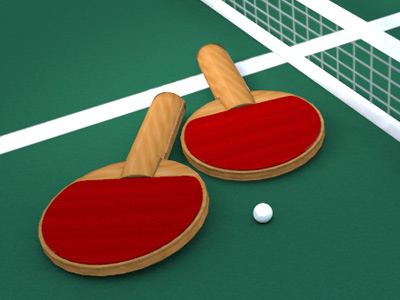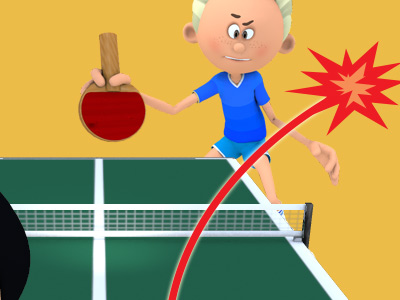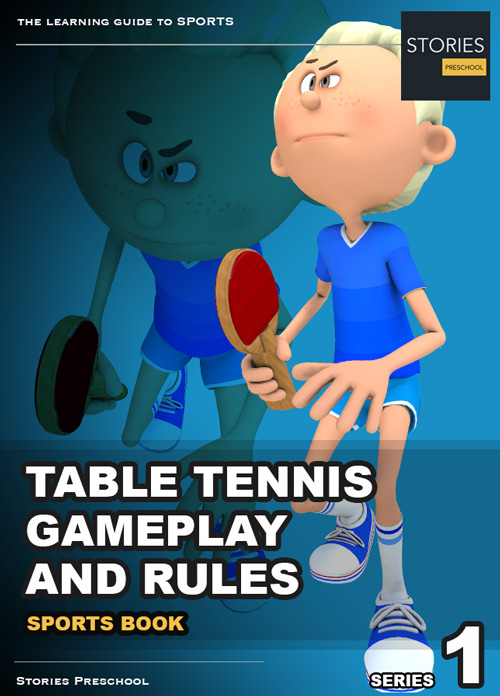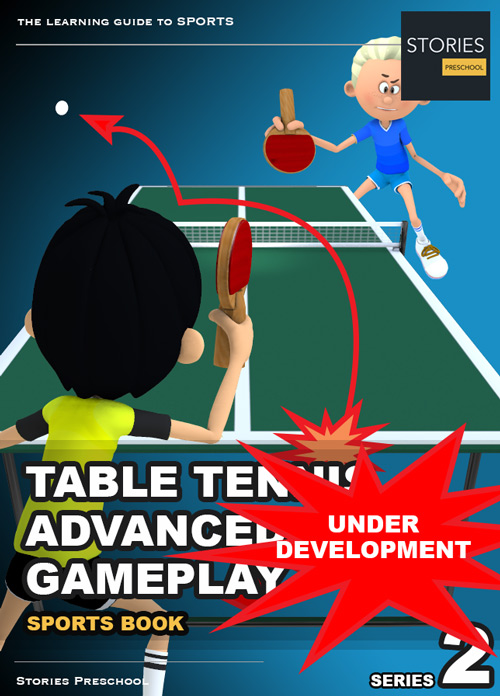Table Tennis
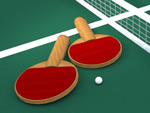
Effects of Spin
Adding spin onto the ball causes major changes in table tennis gameplay. Although nearly every stroke or serve creates some kind of spin, understanding the individual types of spin allows players to defend against and use different spins effectively.

Backspin
Backspin is where the bottom half of the ball is rotating away from the player, and is imparted by striking the base of the ball with a downward movement. At the professional level, backspin is usually used defensively in order to keep the ball low. Backspin is commonly employed in service because it is harder to produce an offensive return, though at the professional level most people serve sidespin with either backspin or topspin. Due to the initial lift of the ball, there is a limit on how much speed with which one can hit the ball without missing the opponent's side of the table. However, backspin also makes it harder for the opponent to return the ball with great speed because of the required angular precision of the return. Alterations are frequently made to regulations regarding equipment in an effort to maintain a balance between defensive and offensive spin choices. It is actually possible to smash with backspin offensively, but only on high balls that are close to the net.
Topspin
The topspin stroke has a smaller influence on the first part of the ball-curve. Like the backspin stroke, however, the axis of spin remains roughly perpendicular to the trajectory of the ball thus allowing for the Magnus effect to dictate the subsequent curvature. After the apex of the curve, the ball dips downwards as it approaches the opposing side, before bouncing. On the bounce, the topspin will accelerate the ball, much in the same way that a wheel which is already spinning would accelerate upon making contact with the ground. When the opponent attempts to return the ball, the topspin causes the ball to jump upwards and the opponent is forced to compensate for the topspin by adjusting the angle of his or her racket. This is known as "closing the racket". The speed limitation of the topspin stroke is minor compared to the backspin stroke. This stroke is the predominant technique used in professional competition because it gives the opponent less time to respond. In table tennis topspin is regarded as an offensive technique due to increased ball speed, lower bio-mechanical efficiency and the pressure that it puts on the opponent by reducing reaction time. (It is possible to play defensive topspin-lobs from far behind the table, but only highly skilled players use this stroke with any tactical efficiency.) Topspin is the least common type of spin to be found in service at the professional level, simply because it is much easier to attack a top-spin ball that is not moving at high speed.

Sidespin
This type of spin is predominantly employed during service, wherein the contact angle of the racket can be more easily varied. Unlike the two aforementioned techniques, sidespin causes the ball to spin on an axis which is vertical, rather than horizontal. The axis of rotation is still roughly perpendicular to the trajectory of the ball. In this circumstance, the Magnus effect will still dictate the curvature of the ball to some degree. Another difference is that unlike backspin and topspin, sidespin will have relatively very little effect on the bounce of the ball, much in the same way that a spinning top would not travel left or right if its axis of rotation were exactly vertical. This makes sidespin a useful weapon in service, because it is less easily recognized when bouncing, and the ball "loses" less spin on the bounce. Sidespin can also be employed in offensive rally strokes, often from a greater distance, as an adjunct to topspin or backspin. This stroke is sometimes referred to as a "hook". The hook can even be used in some extreme cases to circumvent the net when away from the table.
Corkspin
This type of spin is almost exclusively employed in service, but it is also used from time to time in the lob at the professional level. Unlike any of the aforementioned techniques, corkspin (sometimes referred to as "drill-spin") features a unique situation in which the axis of spin is more or less parallel to the trajectory of the ball. This means that the Magnus effect will have little to no effect on the trajectory of a cork-spun ball.

Upon bouncing, the ball will dart right or left, depending on the direction of the spin, making it very difficult to return. Although in theory this type of spin produces the most obnoxious effects, it is not as strategically practical as sidespin or backspin in terms of the limitations that it imposes upon the opponent during their return. Aside from the initial direction change when bouncing, provided that it does not exceed the reach of the opponent, a cork-spun ball is easily countered with topspin or backspin. Similar to a backspin stroke, the corkspin stroke has a lower maximum velocity, simply due to the contact angle of the racket when producing the stroke. To impart a spin on the ball which is parallel to its trajectory, the racket must be swung more or less perpendicular to the trajectory of the ball. This greatly limits the amount of forward momentum that can be transferred to the ball by the racket. Corkspin is almost always mixed with another variety of spin, as it is less effective and harder to produce on its own.

SPORTS

RESOURCES
This article uses material from the Wikipedia article "Table Tennis", which is released under the Creative Commons Attribution-Share-Alike License 3.0.
© Stories Preschool. All Rights Reserved.

